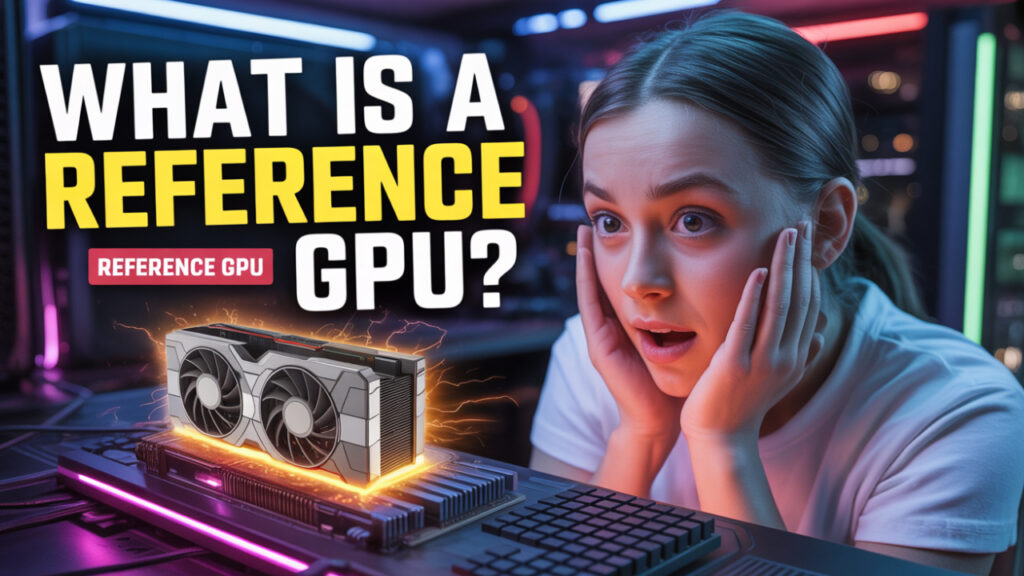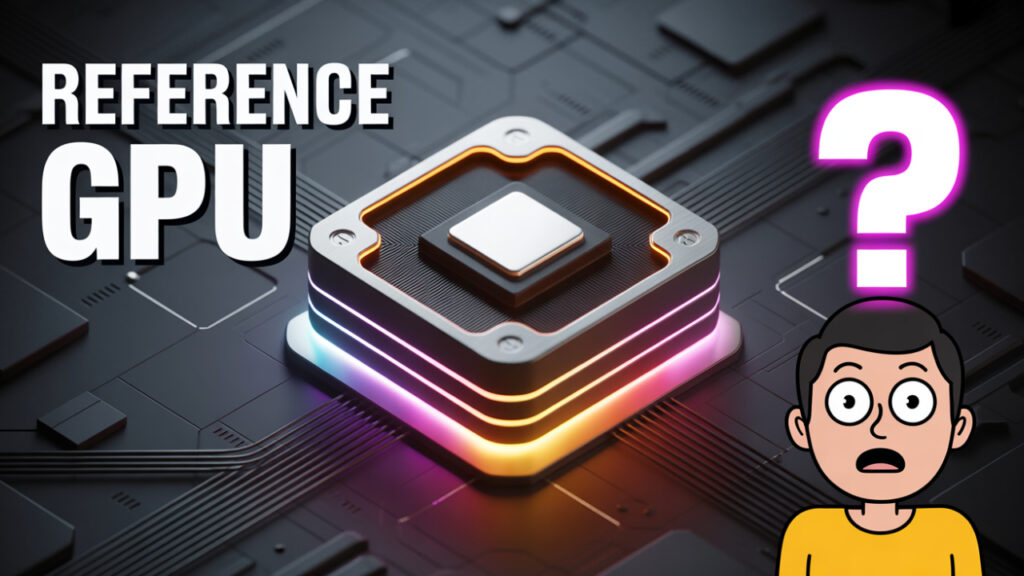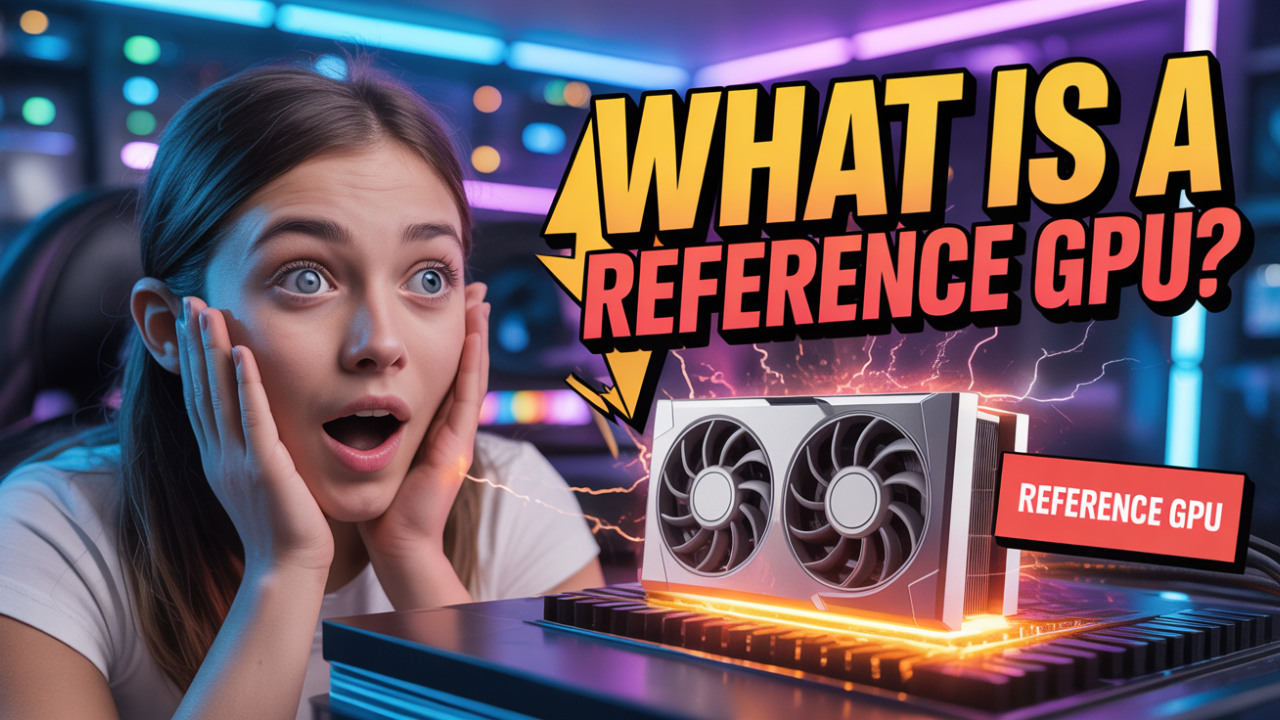A reference GPU is the standard graphics card model created by the original chip maker like NVIDIA or AMD. When asking what is a reference GPU? it refers to the first version released with default cooling, power limits, and design, serving as the base model for custom cards built by other manufacturers.
In this complete 2000-word guide, we’ll cover everything you need to know about reference GPUs—from their design, benefits, limitations, and how they compare to custom or aftermarket GPUs. This article is SEO-optimized, easy to understand, and ideal for both beginners and enthusiasts.
What Is a Reference GPU?
A Reference GPU, also known as a Founders Edition GPU (especially in NVIDIA’s lineup), is the original version of a graphics card released by the GPU manufacturer—NVIDIA or AMD. It is the first version of the card, designed and built according to the company’s default specifications, cooling solution, and power limits.
In simple words, a reference GPU is the baseline model that sets the standard for other manufacturers to build upon.

Who Makes Reference GPUs?
The two main GPU makers are:
- NVIDIA – Their reference models are often branded as Founders Edition.
- AMD – also creates reference designs for their Radeon GPUs.
These companies design the GPU chip and also manufacture a basic version of the graphics card to demonstrate its performance.
After that, they allow third-party partners, such as ASUS, MSI, Gigabyte, Zotac, EVGA, and Sapphire, to create custom or aftermarket versions with enhanced cooling, factory overclocks, and custom PCBs.
Key Features of a Reference GPU
- Stock Design: Clean and minimalistic look, often using a blower-style cooler.
- Standard PCB and Power Limit: Built to the manufacturer’s default settings.
- Lower Noise and Power Efficiency: Designed to run within safe limits.
- It is ideal for Small Form Factor (SFF) builds due to compact size.
- Early Availability: Reference cards are usually available at launch.
Reference GPU vs Custom GPU – What’s the Difference?
Let’s break down the main differences between a reference GPU and an aftermarket/custom GPU:
| Feature | Reference GPU | Custom GPU |
|---|---|---|
| Cooling | Blower-style or dual-fan by brand | Triple-fan, advanced heatsinks, liquid cooling options |
| Clock Speed | Default settings | Often overclocked |
| Design | Standard and minimal | Flashy RGB, custom colors, larger size |
| Price | MSRP (initially) | Can be more expensive |
| Noise Levels | Quieter at low loads | Better overall cooling, less noise at high loads |
| Performance | Baseline | Slightly better due to overclocking and better thermals |
Advantages of Using a Reference GPU
Here are the benefits of buying a reference GPU, especially for specific users or scenarios:
1. Early Access at Launch
Reference GPUs are often the first models released to the public. This means if you’re looking to upgrade immediately on launch day, you’re more likely to find a Founders Edition GPU available before custom models hit the market.
2. Compact Design
Because of their smaller size, reference GPUs are ideal for SFF PCs and mini-ITX builds. Custom GPUs often have three fans and can be too bulky for compact cases.
3. Blower-Style Cooling (Good for Some Cases)
The blower fan pushes hot air out the back of the case, which helps in tight setups where airflow is limited. This is useful for multi-GPU configurations and compact builds.
4. Aesthetic Simplicity
Reference cards often feature a sleek, uniform design that complements minimalist or professional-looking PC builds nicely.
5. Built by the Chip Manufacturer
You’re getting a product built by the same company that made the GPU chip itself. Quality control and compatibility are often top-tier.
Disadvantages of a Reference GPU
Despite the perks, there are some downsides to consider before purchasing a reference GPU.
1. Limited Cooling Efficiency
Reference coolers—especially older blower-style ones—aren’t as efficient as the triple-fan cooling solutions found on custom GPUs.
2. Less Overclocking Headroom
Reference cards come with strict power limits and are not designed for heavy overclocking. Enthusiasts who want to push performance will find better options in custom cards.
3. No RGB or Custom Features
If you’re into building a flashy rig with RGB lights and custom colour themes, reference GPUs won’t provide those aesthetic features.
4. May Run Hotter Under Load
Because of less efficient cooling, reference GPUs may run hotter under extended gaming or heavy rendering workloads.
Are Reference GPUs Cheaper?
Generally, reference GPUs are launched at the Manufacturer’s Suggested Retail Price (MSRP). However, due to limited availability, they can become expensive over time, often through scalping or rarity—especially NVIDIA Founders Editions.
Aftermarket GPUs may be more expensive at launch, but they often offer better cooling and additional features. However, due to market fluctuations, prices for both types can vary wildly.
Should You Buy a Reference GPU?
It depends on your use case, budget, and preferences. Here’s a quick recommendation:
- Buy a Reference GPU if:
- You want early access to the latest GPU.
- You’re building in a compact case.
- You prefer a quieter, minimal design.
- You trust NVIDIA or AMD for quality assurance.
- Skip a Reference GPU if:
- Do you want RGB lighting or custom aesthetics?
- You plan to overclock heavily.
- You’re building a high-end gaming rig and need better cooling.
Examples of Popular Reference GPUs
NVIDIA Reference GPUs (Founders Edition)
- NVIDIA GeForce RTX 4090 Founders Edition
- NVIDIA RTX 3080 Founders Edition
- NVIDIA RTX 3070 Founders Edition
AMD Reference GPUs
- AMD Radeon RX 7900 XTX
- AMD RX 6800 XT Reference
- AMD RX 5700 Reference
These models are direct from the manufacturers and represent the baseline specs and cooling designs.
Can You Upgrade a Reference GPU’s Cooling?
Technically, yes—but it’s not recommended unless you are experienced.
You can:
- Install a water block for custom water cooling.
- Replace the thermal paste or pads for slightly better thermals.
However, doing this voids the warranty and can damage the card if done improperly. If cooling performance is your top priority, it’s best to opt for a custom GPU with a triple-fan or AIO liquid cooling system.
How to Identify a Reference GPU
Here’s how you can spot a reference GPU:
- Manufacturer Branding: Only NVIDIA or AMD logos—no ASUS, MSI, etc.
- Sleek Design: Very minimal, no RGB, compact shape.
- Packaging: “Founders Edition” or “Reference Design” label.
- Blower-Style Cooler: On older cards, a single exhaust fan pushes air out the back.
You can also use the GPU-Z software to confirm the specs or PCB layout.
Where to Buy Reference GPUs
Reference GPUs can be bought from:
- Official NVIDIA or AMD stores.
- Amazon (limited stock).
- Newegg or MicroCenter.
- Second-hand marketplaces like eBay (be cautious).
Due to limited production, they may sell out fast or cost more than MSRP after launch.
Impact of Reference GPUs on the GPU Market
Reference GPUs help establish the performance benchmark and enable board partners to begin developing aftermarket variants. They also:
- Standardize the design language for that GPU generation.
- Allow for fair market competition in pricing and design innovation.
- Serve as a baseline for comparison in reviews and benchmarks.
Without reference GPUs, custom models would lack a clear foundation.

FAQs About Reference GPUs
Is a reference GPU better than a custom one?
Not necessarily. Reference GPUs offer stability and compact size, while custom GPUs provide better cooling and overclocking.
What Is a Non-Reference GPU?
A non-reference GPU is a customized version of a graphics card made by third-party manufacturers like ASUS, MSI, Gigabyte, Zotac, Sapphire, and others
The term GPU stands for Graphics Processing Unit. It refers to a specialized processor designed to handle graphics rendering and parallel computations.
Are NVIDIA Founders Edition cards reference models of the GPUs?
Yes, Founders Edition is NVIDIA’s version of a reference GPU with premium materials and sleek designs.
Can I overclock a reference GPU?
You can, but your headroom is limited due to power and thermal constraints.
Do reference GPUs run hotter?
Yes, usually. Due to limited cooling solutions, they may get warmer than custom GPUs under heavy load.
Why do reference GPUs sell out quickly?
Because they’re often priced at MSRP and released at launch, demand is very high, especially for Founders Editions.
Conclusion
So, what is a reference GPU? It’s the original, manufacturer-designed version of a graphics card, offering a clean design, standard performance, and compact size. While they may not have the flashy features or high-end cooling of custom GPUs, they remain a solid choice for users who value stability, simplicity, and early access.
Whether you’re a first-time builder or a seasoned enthusiast, understanding reference GPUs helps you make smarter, more informed choices when shopping for your next graphics card.
